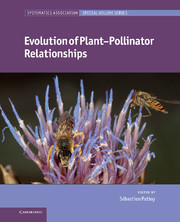Book contents
- Frontmatter
- Contents
- Contributors
- Preface
- 1 Macroevolution for plant reproductive biologists
- 2 Pollination crisis, plant sex systems, and predicting evolutionary trends in attractiveness
- 3 Evolution and ecological implications of “specialized” pollinator rewards
- 4 Fig–fig wasp mutualism: the fall of the strict cospeciation paradigm?
- 5 Fossil bees and their plant associates
- 6 Pollen evidence for the pollination biology of early flowering plants
- 7 Pollinator mediated floral divergence in the absence of pollinator shifts
- 8 Animal pollination and speciation in plants: general mechanisms and examples from the orchids
- 9 Why are floral signals complex? An outline of functional hypotheses
- 10 A survey on pollination modes in cacti and a potential key innovation
- 11 Zygomorphy, area, and the latitudinal biodiversity gradient in angiosperms
- 12 Ambophily and “super generalism” in Ceratonia siliqua (Fabaceae) pollination
- 13 Structure and dynamics of pollination networks: the past, present, and future
- 14 Pollinators as drivers of plant distribution and assemblage into communities
- 15 Effects of alien species on plant–pollinator interactions: how can native plants adapt to changing pollination regimes?
- 16 Pollen resources of non-Apis bees in southern Africa
- 17 Advances in the study of the evolution of plant–pollinator relationships
- Index
- Plate section
- References
5 - Fossil bees and their plant associates
Published online by Cambridge University Press: 05 January 2012
- Frontmatter
- Contents
- Contributors
- Preface
- 1 Macroevolution for plant reproductive biologists
- 2 Pollination crisis, plant sex systems, and predicting evolutionary trends in attractiveness
- 3 Evolution and ecological implications of “specialized” pollinator rewards
- 4 Fig–fig wasp mutualism: the fall of the strict cospeciation paradigm?
- 5 Fossil bees and their plant associates
- 6 Pollen evidence for the pollination biology of early flowering plants
- 7 Pollinator mediated floral divergence in the absence of pollinator shifts
- 8 Animal pollination and speciation in plants: general mechanisms and examples from the orchids
- 9 Why are floral signals complex? An outline of functional hypotheses
- 10 A survey on pollination modes in cacti and a potential key innovation
- 11 Zygomorphy, area, and the latitudinal biodiversity gradient in angiosperms
- 12 Ambophily and “super generalism” in Ceratonia siliqua (Fabaceae) pollination
- 13 Structure and dynamics of pollination networks: the past, present, and future
- 14 Pollinators as drivers of plant distribution and assemblage into communities
- 15 Effects of alien species on plant–pollinator interactions: how can native plants adapt to changing pollination regimes?
- 16 Pollen resources of non-Apis bees in southern Africa
- 17 Advances in the study of the evolution of plant–pollinator relationships
- Index
- Plate section
- References
Summary
Introduction
The bees comprise a derived monophyletic group (Anthophila) of pollen-consuming (secondarily phytophagous) wasps of the superfamily Apoidea, and that diverged from a grade of predatory apoid wasps (formerly “Sphecidae”) sometime in the mid Cretaceous (~120–125 megaannum) (Michener 1944, 1979, 2007; Brothers 1975, 1998; Alexander 1992; Ronquist 1999; Engel 2001a, 2011; Danforth et al. 2006). Seven contemporary families are usually acknowledged: Andrenidae, Apidae, Colletidae, Halictidae, Melittidae, Megachilidae and Stenotritidae, including ~1200 genera and ~20 000 species (Michener 2007; Engel 2005, 2011). Two fossil families are also described: Paleomelittidae from middle Eocene Baltic amber, and a stem-group, Melittosphecidae from Cretaceous Burmese amber which, as discussed below, may or may not be a bee (Engel 2001a; Poinar and Danforth 2006; Ohl and Engel 2007). Bees likely arose concomitantly with the diversification of flowering plants (angiosperms) (Michener 1979; Grimaldi 1999; Engel 1996, 2001a; Crepet et al. 2004; Grimaldi and Engel 2005). Represented by more than 250 000 described species, angiosperms are the most diversified group of vascular plants, covering nearly all terrestrial and many aquatic habitats (Soltis and Soltis 2004). The congruent rise of flowering plants and numerous phytophagous insect lineages, such as bees, ditrysian Lepidoptera, and various flowering-visiting beetles and flies, has fuelled the notion of coradiation between these lineages. Such a conclusion is supported by the observation of flowers with specific combinations of traits that are correlated with particular pollinators (Bronstein et al. 2006). Selection for insect-pollinated clades is also supported by the fact that deliverance by pollinators of unconsumed pollen to the host plant’s female reproductive organs is clearly less stochastic and more efficient than alternative ancestral wind, water or gravity dispersive methods (Labandeira 1998). Lastly, association with pollinators increases opportunities for the evolution of specialization and subsequent diversification (Vamosi and Vamosi 2010).
- Type
- Chapter
- Information
- Evolution of Plant-Pollinator Relationships , pp. 103 - 164Publisher: Cambridge University PressPrint publication year: 2011
References
- 9
- Cited by

